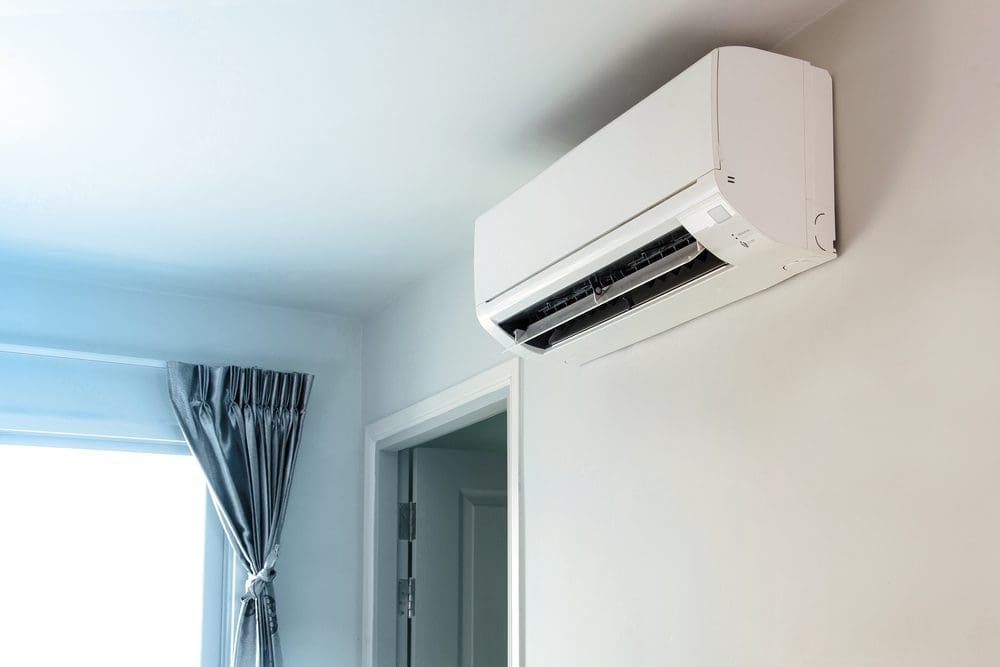
Ducts be gone! According to the U.S. Energy Information Administration, more than 1.75 million American homes use ductless air conditioning to warm and cool air. The ductless AC industry grows yearly as more Americans discover how valuable ductless heating and cooling can be. If you want to enhance your home’s air conditioning, you need to install a ductless AC system. Before you call a ductless AC installer, you should inform yourself about ventless air conditioner systems to find the perfect device for your needs. Here is your essential guide to ductless air conditioning.
Table of Contents
What Is Ductless AC?
A ductless AC system (also called a mini-split) is a form of ventless air conditioner consisting of an outdoor unit and one or more indoor units. Capable of both heating and cooling, ductless AC systems usually contain two pieces of equipment:
- An outdoor compressor and condenser can cool and heat air before it enters your home.
- An indoor air handler dumps the heated or cooled air into your home.
Electrical cables and refrigerant lines connect the two units, not ducts.
How Does Ductless AC Work?
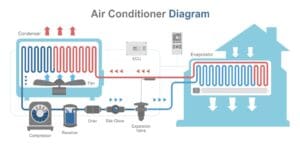
The outdoor compressor pumps chemicals called refrigerants to the indoor unit. The refrigerants are liquids, but they can turn into gas and remove heat and humidity from the air blowing across coils in the indoor unit. The air handler can then distribute cool and less humid air into your home.
The gas refrigerant travels to the outdoor compressor, which converts it back into a liquid. The compressor’s coil can release heat energy, keeping your home cool.
You can reverse the process to heat your home. The interior unit can add heat to the indoor air, and your coils can carry cold air outside.
Ductless AC systems do not use fans to distribute the air. The indoor air handler operates only inside the room, cooling the air in that space. If you want to cool the air in different rooms in your house, you must install multiple air handlers.
Single Zone vs Multi-Zone Mini Split
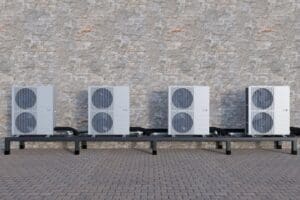
Single zone mini split systems have one indoor unit connected to one outdoor compressor. The system cools and warms one room in your home.
On another hand, multi-zone mini split systems have multiple indoor units in different rooms, usually a maximum of four or five. Each unit is connected to a single outdoor condenser. If you install two or three units, you can add additional ones.
Multi-zone mini split systems let you control the temperature in different rooms but require a more extended installation period. Air handlers located far away from the outdoor compressor need long refrigerant and electric lines, which can pose a safety risk.
You can program each mini split AC unit to any temperature you want. For example, one room can be 68 degrees, while another can be 70 degrees. Customizing the temperature can be helpful if you have plants or pets sensitive to the temperature. You can also use one unit for air conditioning in a garage.
Ductless AC Pros
Ductless air conditioning has many advantages over central AC systems. Here are just a few of them.
1. Energy Efficiency
Central air conditioning systems lose a lot of hot air and electricity because of how central air conditioning works. Central AC systems require long ducts to circulate air, many of which have gaps that allow the air to escape. The air conditioner needs more electricity to warm the air, driving your electrical bills up.
Ductless systems use less electricity because they don’t lose warm air between their ducts. They also have fewer parts that require electricity and use fewer resources, decreasing your carbon footprint.
ENERGY STAR ductless air conditioners use up to 60% less energy than standard AC units, making them energy efficient air conditioner systems. You may save hundreds of dollars on your energy bill every year by switching to an energy-efficient air conditioner.
get an energy performance evaluation
2. Less Hassle
Ductwork requires a lot of time and effort to install. Installation teams must drill holes in your wall, put the ductwork in its place, and patch over the holes they make.
On another hand, ventless air conditioner systems are easy to install. A technician must drill small holes in your wall to run the electrical and refrigerant lines to the exterior device. None of these holes are large, and your technician does not need to patch or paint too much.
3. Customizability
Central AC systems make your entire home the same temperature. They warm and cool areas of your home you’re not using and do not have insulation, meaning you lose a lot of electricity and the ability to control the temperature exactly as you want.
Ductless air conditioning lets you customize each room’s temperature. You do not need a unit in places like your attic if you don’t use those locations. You can therefore better install AC in specific rooms. Ventless air conditioner systems are great for air conditioning a garage for example.
Ductless AC Cons
Before installing a ductless AC system, think about some of the downsides of a system.
1. High Upfront Cost
Some ductless systems have a very high upfront cost, sometimes thousands of dollars. This makes traditional systems cheaper in the short term. However, you will save money long-term because you spend less on electricity with a ventless air conditioner.
2. Intrusive
Ventless air conditioner units go on your floor, wall, or ceiling. These units take up space in your home and give less room for furniture, artwork, plants, and other objects.
Some people regard mini-splits as unsightly. You can buy a product that looks similar to your wall, but you will still notice it. Mini-splits make a low noise level as they operate, which can be distracting.
Is Ductless AC Right for Your Home?
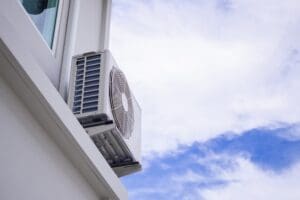
Don’t assume that ductless AC systems are unsuitable for your home. Think about a few factors that can help you make up your mind.
If You Already Have Air Vents
You can install a ductless AC system even if your home has air vents. They can affect where you place your indoor unit; if they take up space on your ceiling, you may need to mount the indoor air handlers on your walls.
You can avoid problems by placing your indoor units on your perimeter walls. Most vents move away from the perimeter, and your technician can run refrigerant and electrical lines to your exterior compressor effortlessly.
Better for Small or Big Houses?
Small and big homes can benefit from ductless mini-splits. However, they may be better for small homes, as the system has less air to cool and circulate.
You need a multi-zone system for a large home. You may need to install multiple exterior units to control the temperature in all your rooms. To make installation convenient, you can place external compressors in different locations so your HVAC technician does not have to run long cables through your home.
Size Consideration
The bigger your room is, the bigger your mini-split needs to be. A mini-split that is too small can break down from overworking, and you may not feel cool or warm air coming from it.
The size of ductless air conditioners is measured in BTUs of cooling and heating power. You need 6,000 BTUs of capacity for a room between 150 and 250 square feet. You need 12,000 BTUs for a 500-square-foot room and 18,000 for a 1,000-square-foot space.
Ductless AC Cost
The average mini-split air conditioner costs $3,000 to install. Low-end products can cost $2,000, and high-end products can cost $14,500. You will need to shop around to find affordable air conditioners.
The average mini-split lasts 20 years, and you can save hundreds of dollars in electricity bills each year. This means that you will start saving money by switching to your ductless AC within ten years of installation.
Impact on Airflow and Indoor Air Quality
Mini-splits have filters that remove particulates from the air, promoting your air quality. Check the AC SEER rating of your mini-split to know how good your unit is at improving the air quality.
All mini-splits will help with airflow, but where you mount your mini split unit can impact how much air you feel. Floor-mounted units throw cool air upward, which means the airflow is worse than wall-mounted and ceiling-mounted devices.
Mini-splits can remove moisture from the air, reducing humidity. They can operate in the summer and winter, providing consistent air quality throughout the year.
Do you need advice on installing a ductless AC system? Schedule an appointment with a professional mini-split technician at Hurley and David today.
Ductless AC Installation
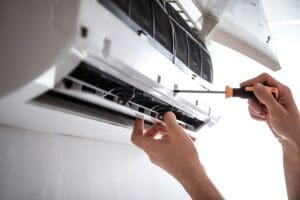
Ventless air conditioner systems are easier to install than central AC systems. However, you should not install the units by yourself. You risk harming yourself as you set up the electric lines, or you may drill holes in the wrong places.
Professional HVAC technicians can inspect your home, find the right places for your units, and handle the whole mini-split installation process. After they’re done, they can test your system and help you maintain it.
Technicians need wall brackets, condenser pads, and the system equipment itself. You need to give them access to your wall and the exterior of your home. If you don’t have a lot of room around your property, your technician can place your external unit on the wall or roof of your building.
Contact Hurley & David to know more about Ductless AC installation options! We offer FREE ESTIMATES!


